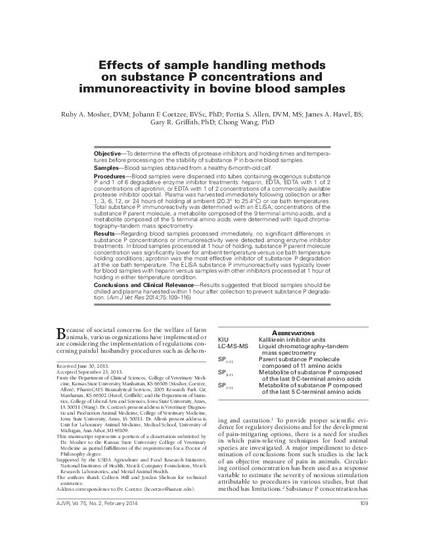
Objective—To determine the effects of protease inhibitors and holding times and temperatures before processing on the stability of substance P in bovine blood samples.
Samples—Blood samples obtained from a healthy 6-month-old calf.
Procedures—Blood samples were dispensed into tubes containing exogenous substance P and 1 of 6 degradative enzyme inhibitor treatments: heparin, EDTA, EDTA with 1 of 2 concentrations of aprotinin, or EDTA with 1 of 2 concentrations of a commercially available protease inhibitor cocktail. Plasma was harvested immediately following collection or after 1, 3, 6, 12, or 24 hours of holding at ambient (20.3° to 25.4°C) or ice bath temperatures. Total substance P immunoreactivity was determined with an ELISA; concentrations of the substance P parent molecule, a metabolite composed of the 9 terminal amino acids, and a metabolite composed of the 5 terminal amino acids were determined with liquid chromatography–tandem mass spectrometry.
Results—Regarding blood samples processed immediately, no significant differences in substance P concentrations or immunoreactivity were detected among enzyme inhibitor treatments. In blood samples processed at 1 hour of holding, substance P parent molecule concentration was significantly lower for ambient temperature versus ice bath temperature holding conditions; aprotinin was the most effective inhibitor of substance P degradation at the ice bath temperature. The ELISA substance P immunoreactivity was typically lower for blood samples with heparin versus samples with other inhibitors processed at 1 hour of holding in either temperature condition.
Conclusions and Clinical Relevance—Results suggested that blood samples should be chilled and plasma harvested within 1 hour after collection to prevent substance P degradation.
Available at: http://works.bepress.com/chong-wang/73/

This article is from American Journal of Veterinary Research 75 (2014): 109, doi: 10.2460/ajvr.75.2.109. Posted with permission.